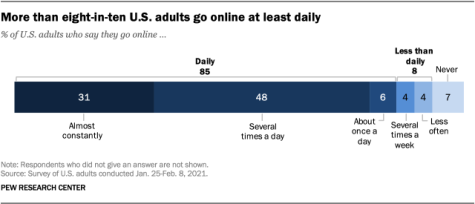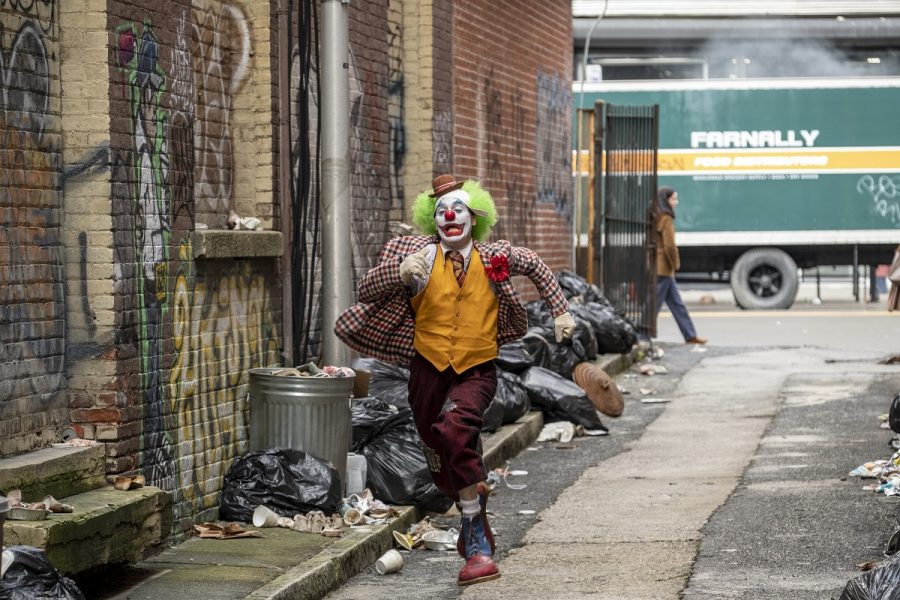Social Commentary in Modern Day Films
February 23, 2022
Social commentary has been an age-old idea of using rhetorical means to provide commentary on issues in a society; however, as of recent times, it has sneakily crept into mainstream pop culture, namely movies. Movies are a form of entertainment many enjoy frequently: they exist as a pleasurable viewing experience and as a way to see a story across a multitude of different genres. While this idea remains true, the 2010s have certainly paved a path for a new style of films; a style in which key social issues are tackled headfirst through different forms of media for many to enjoy. With the rise in use of social commentary in our modern day films, it poses the question: Why has social commentary in movies increased recently? And why do movies like these resonate with audiences so well?
“31% of U.S. adults now report that they go online ‘almost constantly,’ up from 21% in 2015,” states a new survey from the Pew Research Center. “Overall, 85% of Americans say they go online on a daily basis.” Using the internet and going online has become a way of life for many, even being a necessity for many jobs. As a result of this new, digital society, social media has developed as a necessary by-product; existing within a group of online platforms in which people can share and voice their opinions on any topics of their choosing in a fast and efficient way.

“More than 80 percent of Gen Z say they use social media to talk about issues they care about,” according to a Cone Communications survey. Due to the rise of social media, people have been able to go on their respective platforms and learn of social issues. Simultaneously being able to engage in them just through the comfort of their screens.
Through the use of social media, social issues have become exponentially more tangible for the majority of the population. A survey from the Pew Research Center states, “65% of respondents believe social networks highlight important issues that might otherwise not receive attention.”
With social issues garnering more exposure than ever before, the 41.7 billion dollar film industry is also expecting major growth. “The U.S. is among the top ten countries with the highest forecast growth rate of filmed entertainment revenue between 2019 and 2024, with an increase of over 25 percent estimated for that period,” states Statista, a database specializing in market and consumer data.
With social issues being represented in media much more frequently, alongside substantial gains in the film industry, it is no wonder that movies have begun to encapsulate stories that reflect present-day issues. Films have broken a boundary in which new stories are being created based on familiar topics. Creating stories that revolve around important social issues, films have found a new way in captivating audiences that don’t feel forced in any way, rather, a breath of fresh air.
Films such as The Shape of Water and Green Book, movies with social commentary engraved within their respective stories have gathered much acclaim from both the audience and critics, thanks to the rise of awareness in said topics.
The 2010 Academy Award Winner for Best Picture, “The Hurt Locker,” is a film that, while released only a decade ago, sets a meaningful scale for the growth in social commentary. The Hurt Locker encompasses anti-war themes through displaying its potential destructive capabilities and paranoia that spreads amongst soldiers. Although rich in the way the film tries to deliver the message, the film falls flat because of how inapplicable the themes are. The idea of “war is bad” is a subject very few can relate to, let alone act as the main point of the film. 
Many of the award winning films of recent years have reflected on this idea of social commentary and delivered an impactful message through a new type of storytelling. Todd Phillips’ 2019 Oscar winning film, The Joker, and Bong Joon-Ho’s 2020 Academy Award winning film for Best Picture, Parasite, have both taken this trope and spun it around a hyper-realistic society, giving the chance for audience members to fully digest what is being said.
Films such as The Joker, and Parasite lean into the factor of realism: the compelling nature of these films are built on the fact that the scenarios presented are completely plausible. As a result, when compared to comic book movies for example, and any blockbuster for that matter, films with the essence of commentary are able to display themes that are unique, exclusively to the story that is trying to be told. Originality is what keeps the film industry dynamic. By keeping stories realistic, films can have a sense of groundedness, a breath of fresh air that only films with social commentary can embody.
The Joker, as mentioned before, is a prime example of how relevant social commentary can be put to use in a modern day film in a narratively beneficial way. The film follows Arthur Fleck, a mentally unstable and failed comedian of Gotham City. “Isolated, bullied, and disregarded by society,” Fleck begins a descent into madness with just one bad day.
What comes off as just an “underdog” story, is rather a fraction of the film. Amongst many themes, two main issues come to mind that are reflected both in the world of The Joker and present day society: the social-political structure of the country and the disregard for mental health. The Joker provides more context for the idea that there is no middle class in our society, only leaving space for the lower class and the upper class in today’s social structure. While the rich live their lives unscathed in the cesspool that is Gotham City, people like Arthur are kicked away to the side.
The lack of empathy for others and the dismissal of mental health is further exacerbated when Arthur is seen on live TV after a failed stand-up session. When he is later asked to be a guest on the Murray-Franklin show, a late night talk show, he is used only for a joke; a symbol of how useless the lower class is depicted as for the “elites” of society.






